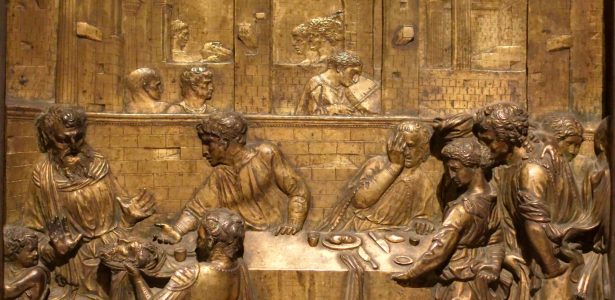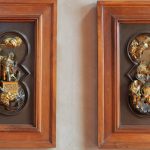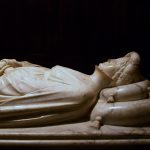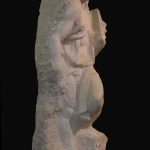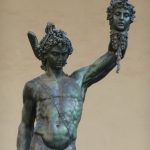Renaissance artists and intellectuals keenly debated the relative worthiness of painting and sculpture. This hot topic of the day was called the paragone (Italian, comparison) and was paralleled by a discussion of the relative merits of painting and poetry. Leon Battista Alberti’s treatise On Painting (1435) asserted the pre-eminence of painting, but the first comprehensive written discussion appears to have been compiled by Leonardo da Vinci and was scattered through his, then unpublished, notebooks. Leonardo of course defended painting, arguing for the supremacy of painting over the arts of poetry, music, and sculpture:
“A sculptor says that his art is more worthy than painting because, fearing humidity, fire, heat, and cold less than painting, it is more eternal. The response to him is that such a thing does not make the sculptor more dignified because the permanence is born from the material and not from the artificer.
Sculpture is missing the beauty of colours, it is missing the perspective of colours, it is missing the perspective and confusion of boundaries of things distant from the eye, because the boundaries of things nearby will be known just like those which are distant. The air interposed between a distant object and the eye will not fill the space around that object more than it does around a nearby object. [Sculpture] will not produce lucid and transparent bodies like veiled figures which show nude flesh under veils laid against it. It will not produce the minute pebbles of varied colours below the surface of transparent water.
The prime marvel to appear in painting is that it appears detached from the wall, or some other plane, and that it deceives subtle judges about that thing that is not divided from the surface of the wall. In this [specific] case, when the sculptor makes his works, what appears is as much as there is. This is the reason the painter needs to make it his duty to know how the shadows are accompanied by the lights. This science is not needed by the sculptor because nature helps his works just as it makes all other corporeal things. When light is taken away from these things, they are of the same colour, and when the light is restored, they are of varied colours, that is chiaroscuro. The second thing that the painter with great discourse needs is to place the true quality and quantity of the shadow and lights with subtle investigation. Here nature alone puts them in the work of the sculptor. Perspective, a most subtle investigation and invention of mathematical studies, by the power of lines, makes what is nearby appear remote, and what is small appear great. Sculpture is helped by nature in this respect and does it without any invention by the sculptor.”
Leonardo da Vinci, excerpts from Codex Vaticanus Urbinas 1270, translation Claire J Farago, 1992.
Castiglione’s The book of the Courtier (1528) also addressed the rivalry of the arts and asserted that painting required “greater artistry” than sculpture. This culminated in the Florentine humanist Benedetto Varchi’s questionnaire (c.1543-) sent to the sculptors (including Michelangelo who only reluctantly took part in the debate, recommending that men “desist from all these disputes which take more time than does the making of figures.” and Benvenuto Cellini) and painters (including Pontormo and Vasari).
Interestingly, our Renaissance biographer and court artist to Duke Cosimo I de’ Medici, Giorgio Vasari, in his agenda of the great progress of the arts wrote about the significance of sculpture in the “Preface to Part III” of his Lives of the Artists (1568). Vasari saw knowledge of the sculpture of antiquity as a catalyst to the move from early Renaissance style, with its, “lack of finish, perfection, delicacy, refinement, and supreme grace …” to the High Renaissance artists, stating “indeed, their successors were enabled to attain to it through seeing excavated out of the earth certain antiquities cited by Pliny [Pliny the Elder, AD 23-79, author of Natural History] as amongst the most famous, such as the Laocoön, the Hercules, the Great Torso of the Belvedere, and likewise the Venus, the Cleopatra [Sleeping Ariadne], the Apollo, and an endless number of others, which, both with their sweetness and their severity, with their fleshy roundness copied from the greatest beauties of nature, and with certain attitudes which involve no distortion of the whole figure but only a movement of certain parts, and are revealed with a most perfect grace, brought about the disappearance of a certain dryness, hardness, and sharpness of manner, which had been left to our art by the excessive study of … [Vasari then lists the 15th century artists starting with Piero della Francesca].”
The paragone might seem a facile argument to us, but it serves as further evidence for the newly acquired status of the Renaissance artist in society, with this debate among both artists and intellectuals contributing to an appreciation of both painting and sculpture as worthy of the heightened status of the liberal arts.
Antique sculptures mentioned by Giorgio Vasari in the “Preface to Part III” of The Lives of the Artists, 1568
The Belvedere Torso was first documented 1432-1435 in the collection of Cardinal Prospero Colonna in Rome; then in the home of sculptor and antique collector Andrea Bregno until 1503; and in Palazzo Colonna at the Sack of Rome in 1527 and damaged. Then taken to the Vatican, put in Julius II’s Cortile del Belvedere by the mid-1500s, alongside the Apollo Belvedere, Laocoön etc. Greatly admired by Michelangelo who said, “Here is the work of a man who knew more than nature”. We can see the muscularity and intensity of this in Michelangelo’s Sistine Chapel paintings, Moses sculpture and Medici Chapel sculptures.
The Apollo Belvedere was discovered in 1489 during building works in Rome, near where Giuliano della Rovere was abbot before he became Pope Julius II. He later transferred it to the sculpture court of the Belvedere, hence the name Apollo Belvedere. The lower part of the right arm and the left hand were missing when discovered (restored by Giovanni Angelo Montorsoli, pupil of Michelangelo). Firstly received very little notice from artists (1490s in a book of drawings by a pupil of Domenico Ghirlandaio) but, once it was installed in the sculpture court, it became well-known and copied in engravings and sculpture, spreading the pose throughout Europe.
The subject of the Laocoön is the Trojan priest Laocoön and his sons Antiphantes and Thymbraeus being strangled by sea serpents. Laocoön was already known through Pliny the Elder’s pioneering encyclopaedia of the ancient world, Natural History, a great source for the art and artists of antiquity in the Renaissance. Pliny had stated that Laocoön and his sons was, "a work to be preferred to all that the arts of painting and sculpture have produced" So, this was a particularly exciting find. This marble group was found 14 January 1506 in a Roman vineyard. Michelangelo, architect Giuliano da Sangallo and son Francesco da Sangallo (later a sculptor) were present at the disinterring. Julius II took ownership and placed it in his new Belvedere Courtyard. The muscle bound, Hellenistic, struggling and dramatic group was influential to artists ever since. A missing fragment of arm of Laocoön was found in a builder’s yard 1906 and reattached correctly in 1957.
Renaissance Sculpture and the competition for the Florentine Baptistery doors
Filippo Brunelleschi (1377-1446)
Florentine early Renaissance sculptor, goldsmith, architect. Lost the competition for the Baptistery doors to Ghiberti. Pioneer in the development of scientific perspective. Created the dome of Florence Duomo, San Lorenzo Church and the Ospedale degli Innocenti.
Lorenzo Ghiberti (1378-1455)
Florentine early Renaissance artist, trained as a goldsmith and sculptor. Ghiberti ran an important metal workshop, training some significant Florentine artists including Donatello, Masolino, Michelozzo and Uccello.
In 1401 the guild responsible for the revered Baptistery of Florence, the Arte di Calimala (cloth finishers and merchants in foreign cloth) announced a competition for a second pair of bronze doors as a sequel to the 14th C doors of Andrea Pisano. The subject was the Old Testament Sacrifice of Isaac. Seven Tuscan artists entered the competition (including the Sienese Jacopo della Quercia) but we have only these two entries remaining. Both Brunelleschi and Ghiberti have coped well with placing this dramatic narrative inside the difficult quatrefoil Gothic shape of a lozenge intersected by four secondary circles. Both have used quotations from antiquity. Ghiberti’s figures are more Gothic and elegant in their proportions and the setting formulaic, while Brunelleschi’s figures are more classical and the setting more naturalistic. Brunelleschi apparently narrowly lost the competition then took up architecture and Ghiberti became a bronze caster of high renown, going onto make two sets of doors for the Baptistery from 1403-1452. This was key for both of their careers. One wonders whether the decision was partly economic, as we can see in the second picture that Ghiberti worked in the revived antique lost wax method of bronze casting, meaning that his panel was cast as a whole and hollow, thus requiring significantly less expensive bronze than Brunelleschi’s which is made from separately cast parts. This may well have swayed the vote for Ghiberti.
Ghiberti’s manuscript of Commentarii (c. 1450-55) contains significant scientific, theoretical and historical ideas on art, as well as what may be the earliest surviving literary autobiography by an artist. Ghiberti affirms the dignity of art as well as evidence of his own ambition:
“I, O most excellent reader, did not have to obey (a desire for) money, but gave myself to the study of art…In order to master the great principles (of art) I have sought to investigate the way nature functions in art; and in order that I might be able to approach her, how images come to the eye, how the power of vision functions, how visual (images) come, and in what way the theory of sculpture and painting should be established”
After discussing his numerous commissions, Ghiberti ends the autobiography by intimating that he was not only good himself, but he also was responsible for the development of other artists around him:
“But not to tire my readers, I shall omit a great many works I have produced. I know that one can find no pleasure in such material. Nevertheless, I ask the pardon of all readers and all to have patience. Also, by making sketches in wax and clay for painters, sculptors and stone carvers and by making designs of many things for painters, I have helped many of them to achieve the greatest honours for their works. Also for him who had to make figures larger than life-size, I gave the rules for executing them with perfect proportion ... Few things of importance were made in our country that were not designed and planned by me.”
An excellent self-promotions exercise!
Ghiberti’s two sets of Baptistery doors. Ghiberti’s 21 years of work on the first Baptistery doors was so successful that he received another commission from the Calimala guild for another set of bronze doors for the same Baptistery. We note his expertise at telling stories in bronze relief. In the second doors, the quatrefoil has been replaced by square fields, the narratives are much more pictorial (sculpture looking like painting) than the earlier doors, in their use of scientific perspective, shallow relief and overall gilding.
Donatello (Donato di Niccolò di Betto Bardi, 1386-1466)
Florentine sculptor. First documented 1404-07 as assistant to Ghiberti on his first bronze Baptistery doors. Pioneer of Brunelleschi’s scientific perspective. Formed business partnerships with Michelozzo. Worked for the Medici. Travelled to Siena, Rome and Padua.
Donatello’s bronze David was a private commission for Cosimo il Vecchio de’ Medici and his son Piero il Gottoso (the Gouty) de’ Medici and thought to have been for the courtyard of the Medici palace in Florence. In terms of technical innovations, in this work Donatello has cast the first life size nude statue in the round for a thousand years.
The iconography has been variously interpreted. Donatello has been innovative in portraying David as the young victorious hero rather than the more customary elderly King. His nudity could refer to Christian purity and virtue and to the nude heroes and athletes of antiquity, which would have appealed to the humanist ideals of the Medici. It is also very erotic. The sinuous pose, the highly polished bronze surface, the sensuous surface textures, the feather of the helmet of Goliath, which curves behind David’s leg and the androgynous ideal seen in the figure, all of which perhaps add homosexual resonances, or may be referencing the idea borrowed from antiquity, from Plato, that ideal beauty came from a combination of the best of the male and female characteristics into one androgynous form. This was in line with the then fashionable philosophical thinking of Neo-Platonism which Cosimo was sponsoring at his villa at Careggi.
Vasari’s biography of Donatello makes much of Donatello’s close, almost symbiotic, relationship with Cosimo de’ Medici who, when he was about to die, left the care of the ageing Donatello to his son, Piero. Piero gave Donatello a farm to provide him with an income. When Donatello died two years after Cosimo de’ Medici, he was buried in the church of San Lorenzo, the Medici family church, with all the honours the people of Florence could afford him.
Jacopo della Quercia (c. 1374 – 1438)
Sienese sculptor and goldsmith, also worked in Lucca, Ferrara, and Bologna. We will see his Fonte Gaia and Baptistery font relief in Siena and Tomb of Ilaria del Carretto in Lucca.
Ilaria del Carretto was the second wife of the unpopular Paolo Guinigi, Lord of Lucca. She died aged 26 after giving birth to a daughter. French courtly costume and dog for fidelity. Classical putti and festoons show awareness of antiquity. Highly finished marble surface.
Fonte Gia. In 1406 the Sienese sculptor Jacopo della Quercia was asked to design and build a new fountain in the Piazza del Campo in Siena. This was to replace the original fountain which had a statue of the pagan goddess Venus. Venus had been blamed for an outbreak of the plague. Apparently, the statue was destroyed and buried outside the city walls to avert its "evil influence". Ghiberti, in his Commentarii, stated that it was placed in rival Florentine territory to bring misfortune! The central Virgin and Child signify the Republic’s devotion to Mary, Christian imagery replacing pagan. This prestigious commission was not just an ornament for the Republic of Siena but an important public utility, the supply of water, a scarce commodity in the region, showing that Jacopo was already being recognised as Siena's most noteworthy sculptor.
Antonio del Pollaiuolo (1429/1433 -1498)
Florentine painter, sculptor, engraver and goldsmith. Ran a large and successful workshop.
Lorenzo il Magnifico de’ Medici employed Pollaiuolo to make this small bronze group of Hercules and Antaeus. Here we see a secular subject for art based on Greek mythology, Hercules slaying the Libyan giant Antaeus who was invincible so long as some part of him touched the earth from which he drew his strength. Hercules held Antaeus in the air in a vice like grip until he weakened and died. In both the use of bronze and in the subject matter we see classical allusions, art imitating the sculpture of antiquity. We also see the use of statuettes for a private setting, the domestic interior. Lorenzo’s preference was for imitations of antiquities and for miniature bronzes. You can imagine him discussing these with his humanist friends. Note Pollaiuolo’s powers of anatomical description and of rendering violent movement and emotion.
Andrea del Verrocchio (c. 1435 – 1488)
Florentine painter, sculptor and goldsmith, master of an important workshop that rivalled that of the Pollaiuolo brothers. His pupils included Leonardo da Vinci, Pietro Perugino and Lorenzo di Credi.
The tomb was commissioned by Lorenzo il Magnifico and his brother Giuliano de’ Medici to commemorate their father Piero and uncle Giovanni. It is double sided, between Brunelleschi’s Old Sacristy of San Lorenzo and the rest of the church, with a bronze rope grill dividing the two spaces. It is made of expensive materials that are difficult to work: red porphyry, green serpentine, marble, pietra serena and bronze. Interestingly, this tomb is devoid of Christian imagery. Rather, it is full of classical motifs and allusions to dynastic claims of the Medici. It is remarkably inventive as a whole and in the decorative detailing, reflecting Verrocchio’s training as a goldsmith.
Michelangelo Buonarroti (1475-1564)
Florentine sculptor, painter, architect, poet; worked mainly in Florence and Rome. Sculpture was his passion and forte and he was a reluctant painter and perhaps architect.
Michelangelo’s Pietà was made for a French cardinal in Rome. This work predated the building of the new St Peter’s in which it now is located, so it was made for Old St Peter’s. Pietà is Italian for pity or mercy. The theme is of one of the Seven Sorrows of the Virgin. The sorrowing Virgin alone with the body of Christ after it had been taken down from the cross. It is the technical virtuosity of Michelangelo that I want to emphasise: the absolute beauty of the two figures in a subject that leaves room for much harsher realism; and the solving of the practical and aesthetic problem of carving out of a single block of marble a woman holding a male adult across her lap, achieved by the cascading drapery over Mary’s lap, forming the base of a visual pyramid with its apex in her head. Giorgio Vasari praised Michelangelo’s work for its beauty and technical perfection, “It would be impossible to find a body showing greater mastery of art and possessing more beautiful members, or a nude with more detail in the muscles, veins and nerves stretched over their framework of bones, or a more deathly corpse … it was miraculous that a formless block of stone could ever have been reduced to a perfection that nature is scarcely able to create in the flesh.” Vasari’s terms of praise included that not only did Michelangelo understand anatomy perfectly, but he was competing with nature itself, imbuing nature with the added quality of perfection.
Michelangelo’s St Matthew was commissioned by the Opera of Florence Duomo. They offered Michelangelo the commission for 12 over life size Apostles for the nave of the Duomo. St Matthew was the only one that Michelangelo ever started because of all the conflicting commissions he kept receiving, having cancelled, or delayed by his patrons. He was recalled to Rome by Pope Julius 11 in 1505 to create the tomb for him, which he never finished, and which continued until 1547. It is an interesting work for its shows Michelangelo’s technique well. He used to draw the front view onto the block of marble then carve uniformly back into the block, like relief sculpture, rather than working on all four sides at once. Thus, the figure has one main view - from the front. Giorgio Vasari compared the gradual emergence of the figure from the marble block to a model in a bath, sunk under water from which the plug is pulled, revealing the front most parts first and then, bit by bit, the rest. Even in its unfinished state, you can note the contrapposto (counterpoised parts of the body around a vertical axis) movement and torsion. You can also see the chisel marks in the marble and the high finish on the left thigh.
Benvenuto Cellini (1500-71)
Goldsmith, medallist, Mannerist sculptor and writer (wrote an Autobiography, 1558-62 and Treatises on goldsmithing and sculpture). Worked in Italy and France. A racy controversial figure who was often in trouble and added to the fierce rivalries amongst artists at the Florentine Medici court. Liked by Duke Cosimo I de’ Medici but disliked by Cosimo’s wife, Eleonora of Toledo.
On his return to Florence from France, under suspicion of having embezzled a large quantity of precious metal that had been supplied by the French King François I, Benvenuto Cellini sought work from Duke Cosimo I de’ Medici. Apparently Cosimo I was pleased to hear of Cellini’s skill at bronze work because he wanted to commission a monumental bronze for the Loggia dei Lanzi on the piazza outside the Palazzo della Signoria, the former Republican palace which then had become the Medici family palace. Cosimo I selected the subject of Perseus and Medusa. In Greek mythology, Perseus is the hero who beheaded Medusa, one of the snake haired Gorgons. The corpse of Medusa lies on a cushion which rests on the capital of a column and Perseus is holding her head in his hand. This work deliberately looks back to other works owned by the Medici, Donatello’s bronze David and Donatello’s Judith and Holofernes in the same loggia for which this work was probably a pendant. Like the latter work, Cellini’s sculpture was symbolic, that any anti-Medici sentiments would be silenced, as a warning to possible troublemakers, as well as intimating that the Medici would protect its citizens. But the work is technically extraordinary, such a large bronze so finely worked. Also, the violence of the subject matter is treated in such an elegant effortless way. We do not see the struggle that has just occurred, just the serene, rather sinister figure of Perseus holding up the head of Medusa. The drama is played down, which makes it more disturbing somehow, and the emphasis is on the sensuousness of the surfaces of hair and skin.
Cellini’s autobiography, a masterpiece of self-promotion, gives a blow by blow and very dramatic account of the casting of the Perseus. We learn about Cellini’s tricky and highly original process from the wax model to the full-sized plaster cast, building the furnace, casting the figures in an alloy of tin and bronze to make them more fluid, the four years it took to clean and chase the bronze on the Perseus figure alone and the elaborately carved marble base with its four bronze statuettes and relief. He also wrote in his autobiography about the power of the artist to bend and shape the human form, moulding the form in wax and clay, distorting and straining the body with his hands. The body of Medusa is folded in half. The artist as creator, like God.
Giambologna (Giovanni Bologna, b. Douai 1529-d. Florence 1608)
Fleming, real name was Jean Boulogne, trained as sculptor in Belgium. To Italy 1554 to continue his education (Rome then Florence) and to find commissions. Cultural crosscurrents in art were becoming more common by now. The influence of Italian artists in France and the Netherlands must have been part of the interest that he had in Italy. He settled in Florence working for Francesco I de’ Medici, son of Cosimo I, and took up the name Giambologna. A Mannerist sculptor.
The story of the abduction of the Sabine women, as recounted by Livy and Plutarch, provided a suitable subject for Renaissance art as an example of the courage of the ancient Romans as well as an excuse to depict multiple semi-nude and struggling figures. But in this case Giambologna’s work was initially a work without a title. He was not really interested in the actual subject, rather, he was more attracted by the compositional exercise, integrating three figures into an action-filled, vertically spiralling group carved out of a single block of marble, a challenge to his technical virtuosity and imaginative powers. Thus, the subject was not as important as displaying the virtuosity of the artist. This was part of the definition of some Mannerist works. There is no real sense of struggle here. The artificiality of the group pose means that from wherever you look at the work it aligns beautifully. It was the first major sculptural group that had no set viewpoints. Rather we see a completely spiralling composition, demanding the spectator to move continuously around the work, admiring the complexity of the design, the merging contrasts of curve, angle, solid and void, the daring under-cutting and projections of the marble limbs.
This was made in the context of Giambologna being in Florence at the time when Cosimo I set up the Accademia del Disegno (Academy of Design) in 1562, with Vasari, Michelangelo and others as founding members and the Duke as its patron. While the Accademia was a way for Cosimo I to control the output of art in his territory, artists were also given a freedom to design works with creativity and invention as the criteria, rather than the traditional idea of art conveying messages. A virtuoso piece of work it is indeed and we have come a long way from the traditional stories of scripture Ghiberti began on the Baptistery doors some 175 years earlier.

